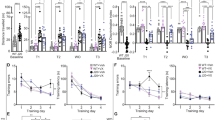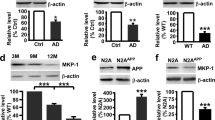Abstract
The majority of Alzheimer’s disease (AD) patients have a late onset, and chronic neuroinflammation, characterized by glial activation and secretion of pro-inflammatory cytokines and chemokines, plays a role in the pathogenesis of AD. The chemokine CCL11 has been shown to be a causative factor of cognitive decline in the process of aging, but little is known whether it is involved in the pathogenesis of AD. In the present study, we showed that CCR3, the receptor for CCL11, was expressed by hippocampal neurons and treatment of primary hippocampal neuronal cultures (14 days in vitro) with CCL11 resulted in activation of cyclin-dependent kinase 5 and glycogen synthase kinase-3β, associated with elevated tau phosphorylation at multiple sites. CCL11 treatment also induced the production of Aβ and dendritic spine loss in the hippocampal neuronal cultures. All these effects were blocked by the CCR3 specific antagonist, GW766994. An age-dependent increase in CCL11, predominantly expressed by the activated microglia, was observed in the cerebrospinal fluid of both APP/PS1 double transgenic mice and wild-type (WT) littermates, with a markedly higher level in APP/PS1 double transgenic mice than that in WT littermates. Deletion of CCR3 in APP/PS1 double transgenic mice significantly reduced the phosphorylation of CDK5 and GSK3β, tau hyperphosphorylation, Aβ deposition, microgliosis, astrogliosis, synaptic loss, and spatial learning and memory deficits. Thus, the age-related increase in CCL11 may be a risk factor of AD, and antagonizing CCR3 may bring therapeutic benefits to AD.






Similar content being viewed by others
References
Alonso Adel C, Mederlyova A, Novak M, Grundke-Iqbal I, Iqbal K (2004) Promotion of hyperphosphorylation by frontotemporal dementia tau mutations. J Biol Chem 279:34873–34881
Bakshi P, Margenthaler E, Laporte V, Crawford F, Mullan M (2008) Novel role of CXCR2 in regulation of gamma-secretase activity. ACS Chem Biol 3:777–789
Bakshi P, Margenthaler E, Reed J, Crawford F, Mullan M (2011) Depletion of CXCR2 inhibits gamma-secretase activity and amyloid-beta production in a murine model of Alzheimer’s disease. Cytokine 53:163–169
Brookmeyer R, Kawas CH, Abdallah N, Paganini-Hill A, Kim RC, and Corrada MM (2016) Impact of interventions to reduce Alzheimer disease pathology on the prevalence of dementia in the oldest-old. Alzheimer’s & dementia: the journal of the Alzheimer’s Association
Burdick D, Soreghan B, Kwon M, Kosmoski J, Knauer M, Henschen A, Yates J, Cotman C et al (1992) Assembly and aggregation properties of synthetic Alzheimer’s A4/beta amyloid peptide analogs. J Biol Chem 267:546–554
Cho SH, Sun B, Zhou Y, Kauppinen TM, Halabisky B, Wes P, Ransohoff RM, Gan L (2011) CX3CR1 protein signaling modulates microglial activation and protects against plaque-independent cognitive deficits in a mouse model of Alzheimer disease. J Biol Chem 286:32713–32722
Crews L, Masliah E (2010) Molecular mechanisms of neurodegeneration in Alzheimer’s disease. Hum Mol Genet 19:R12–R20
Ding Y, Qiao A, Fan GH (2010) Indirubin-3′-monoxime rescues spatial memory deficits and attenuates beta-amyloid-associated neuropathology in a mouse model of Alzheimer’s disease. Neurobiol Dis 39:156–168
Ding Y, Qiao A, Wang Z, Goodwin JS, Lee ES, Block ML, Allsbrook M, McDonald MP et al (2008) Retinoic acid attenuates beta-amyloid deposition and rescues memory deficits in an Alzheimer’s disease transgenic mouse model. J Neurosci Off J Soc Neurosci 28:11622–11634
Duan RS, Chen Z, Dou YC, Concha Quezada H, Nennesmo I, Adem A, Winblad B, Zhu J (2006) Apolipoprotein E deficiency increased microglial activation/CCR3 expression and hippocampal damage in kainic acid exposed mice. Exp Neurol 202:373–380
Dumanis SB, Tesoriero JA, Babus LW, Nguyen MT, Trotter JH, Ladu MJ, Weeber EJ, Turner RS et al (2009) ApoE4 decreases spine density and dendritic complexity in cortical neurons in vivo. J Neurosci Off J Soc Neurosci 29:15317–15322
Erickson MA, Morofuji Y, Owen JB, Banks WA (2014) Rapid transport of CCL11 across the blood-brain barrier: regional variation and importance of blood cells. J Pharmacol Exp Ther 349:497–507
Facci L, Skaper SD (2012) Culture of rodent cortical and hippocampal neurons. Methods Mol Biol 846:49–56
Fischer A, Sananbenesi F, Pang PT, Lu B, Tsai LH (2005) Opposing roles of transient and prolonged expression of p 25 in synaptic plasticity and hippocampus-dependent memory. Neuron 48:825–838
Hanger DP, Betts JC, Loviny TL, Blackstock WP, Anderton BH (1998) New phosphorylation sites identified in hyperphosphorylated tau (paired helical filament-tau) from Alzheimer’s disease brain using nanoelectrospray mass spectrometry. J Neurochem 71:2465–2476
Hasegawa-Ishii S, Inaba M, Li M, Shi M, Umegaki H, Ikehara S, and Shimada A (2015). Increased recruitment of bone marrow-derived cells into the brain associated with altered brain cytokine profile in senescence-accelerated mice. Brain structure & function
He J, Chen Y, Farzan M, Choe H, Ohagen A, Gartner S, Busciglio J, Yang X et al (1997) CCR3 and CCR5 are co-receptors for HIV-1 infection of microglia. Nature 385:645–649
Heppner FL, Ransohoff RM, Becher B (2015) Immune attack: the role of inflammation in Alzheimer disease. Nat Rev Neurosci 16:358–372
Imahori K, Uchida T (1997) Physiology and pathology of tau protein kinases in relation to Alzheimer’s disease. J Biochem 121:179–188
Jarrett JT, Berger EP, Lansbury PT Jr (1993) The C-terminus of the beta protein is critical in amyloidogenesis. Ann N Y Acad Sci 695:144–148
Johnson GV, Hartigan JA (1999) Tau protein in normal and Alzheimer’s disease brain: an update. Journal of Alzheimer’s disease: JAD 1:329–351
Katzman R, Saitoh T (1991) Advances in Alzheimer’s disease. FASEB journal: official publication of the Federation of American Societies for Experimental Biology 5:278–286
Kurt MA, Davies DC, Kidd M, Duff K, Howlett DR (2003) Hyperphosphorylated tau and paired helical filament-like structures in the brains of mice carrying mutant amyloid precursor protein and mutant presenilin-1 transgenes. Neurobiol Dis 14:89–97
Lahiri DK, Chen D, Ge YW, Bondy SC, Sharman EH (2004) Dietary supplementation with melatonin reduces levels of amyloid beta-peptides in the murine cerebral cortex. J Pineal Res 36:224–231
Le Thuc O, Blondeau N, Nahon JL, Rovere C (2015) The complex contribution of chemokines to neuroinflammation: switching from beneficial to detrimental effects. Ann N Y Acad Sci 1351:127–140
Liu SL, Wang C, Jiang T, Tan L, Xing A and Yu JT (2015) The role of Cdk5 in Alzheimer’s disease. Molecular neurobiology
Lovestone S, Reynolds CH (1997) The phosphorylation of tau: a critical stage in neurodevelopment and neurodegenerative processes. Neuroscience 78:309–324
Maphis N, Xu G, Kokiko-Cochran ON, Jiang S, Cardona A, Ransohoff RM, Lamb BT, Bhaskar K (2015) Reactive microglia drive tau pathology and contribute to the spreading of pathological tau in the brain. Brain J Neurol 138:1738–1755
Marciniak E, Faivre E, Dutar P, Alves Pires C, Demeyer D, Caillierez R, Laloux C, Buee L et al (2015) The chemokine MIP-1alpha/CCL3 impairs mouse hippocampal synaptic transmission, plasticity and memory. Scientific reports 5:15862
Mattson MP (2004) Pathways towards and away from Alzheimer’s disease. Nature 430:631–639
Morales I, Guzman-Martinez L, Cerda-Troncoso C, Farias GA, Maccioni RB (2014) Neuroinflammation in the pathogenesis of Alzheimer’s disease. A rational framework for the search of novel therapeutic approaches. Front Cell Neurosci 8:112
Morishima-Kawashima M, Hasegawa M, Takio K, Suzuki M, Yoshida H, Watanabe A, Titani K, Ihara Y (1995) Hyperphosphorylation of tau in PHF. Neurobiol Aging 16:365–371 discussion 371-380
Morris R (1984) Developments of a water-maze procedure for studying spatial learning in the rat. J Neurosci Methods 11:47–60
Neighbour H, Boulet LP, Lemiere C, Sehmi R, Leigh R, Sousa AR, Martin J, Dallow N et al (2014) Safety and efficacy of an oral CCR3 antagonist in patients with asthma and eosinophilic bronchitis: a randomized, placebo-controlled clinical trial. Clinical and experimental allergy: journal of the British Society for Allergy and Clinical Immunology 44:508–516
Rama Rao KV, Kielian T (2015) Neuron-astrocyte interactions in neurodegenerative diseases: role of neuroinflammation. Clinical & experimental neuroimmunology 6:245–263
Sengupta A, Kabat J, Novak M, Wu Q, Grundke-Iqbal I, Iqbal K (1998) Phosphorylation of tau at both Thr 231 and Ser 262 is required for maximal inhibition of its binding to microtubules. Arch Biochem Biophys 357:299–309
Singh TJ, Grundke-Iqbal I, McDonald B, Iqbal K (1994) Comparison of the phosphorylation of microtubule-associated protein tau by non-proline dependent protein kinases. Mol Cell Biochem 131:181–189
van der Meer P, Ulrich AM, Gonzalez-Scarano F, Lavi E (2000) Immunohistochemical analysis of CCR2, CCR3, CCR5, and CXCR4 in the human brain: potential mechanisms for HIV dementia. Exp Mol Pathol 69:192–201
Villeda SA, Luo J, Mosher KI, Zou B, Britschgi M, Bieri G, Stan TM, Fainberg N et al (2011) The ageing systemic milieu negatively regulates neurogenesis and cognitive function. Nature 477:90–94
Villeda SA, Plambeck KE, Middeldorp J, Castellano JM, Mosher KI, Luo J, Smith LK, Bieri G et al (2014) Young blood reverses age-related impairments in cognitive function and synaptic plasticity in mice. Nat Med 20:659–663
Viola KL, Klein WL (2015) Amyloid beta oligomers in Alzheimer’s disease pathogenesis, treatment, and diagnosis. Acta Neuropathol 129:183–206
Walsh DM, Selkoe DJ (2007) A beta oligomers—a decade of discovery. J Neurochem 101:1172–1184
Wang JZ, Xia YY, Grundke-Iqbal I, Iqbal K (2013) Abnormal hyperphosphorylation of tau: sites, regulation, and molecular mechanism of neurofibrillary degeneration. Journal of Alzheimer’s disease: JAD 33(Suppl 1):S123–S139
Wirenfeldt M, Dalmau I, Finsen B (2003) Estimation of absolute microglial cell numbers in mouse fascia dentata using unbiased and efficient stereological cell counting principles. Glia 44:129–139
Xia M, Hyman BT (2002) GROalpha/KC, a chemokine receptor CXCR2 ligand, can be a potent trigger for neuronal ERK1/2 and PI-3 kinase pathways and for tau hyperphosphorylation—a role in Alzheimer’s disease? J Neuroimmunol 122:55–64
Xia MQ, Qin SX, Wu LJ, Mackay CR, Hyman BT (1998) Immunohistochemical study of the beta-chemokine receptors CCR3 and CCR5 and their ligands in normal and Alzheimer’s disease brains. Am J Pathol 153:31–37
Zhang XF, Zhao YF, Zhu SW, Huang WJ, Luo Y, Chen QY, Ge LJ, Li RS et al (2015) CXCL1 triggers caspase-3 dependent tau cleavage in long-term neuronal cultures and in the hippocampus of aged mice: implications in Alzheimer’s disease. Journal of Alzheimer’s disease: JAD 48:89–104
Zhou Y, Tang H, Liu J, Dong J, Xiong H (2011) Chemokine CCL2 modulation of neuronal excitability and synaptic transmission in rat hippocampal slices. J Neurochem 116:406–414
Acknowledgements
We thank Dr. Guo-Huang Fan, professor in Tongji University for the helpful discussion. This work was supported by the National Natural Science Foundation of China (ID81371395), Liaoning Provincial Natural Science Foundation (ID 2015020547), and China Post-doctoral Science Foundation (ID 2015 M581375) to Yi Sui.
Author’s Contribution
YS designed the experiments, oversaw the whole project, and prepared the manuscript. CZ performed the experiments in Figs. 1, 2, and 5 and prepared the manuscript. BX performed the experiments in Figs. 3 and 4. XS performed the experiments in Fig. 6. QZ performed the experiments in Fig. 6
Author information
Authors and Affiliations
Corresponding author
Ethics declarations
Conflict of Interest
The authors declare that they have no conflict of interest.
Rights and permissions
About this article
Cite this article
Zhu, C., Xu, B., Sun, X. et al. Targeting CCR3 to Reduce Amyloid-β Production, Tau Hyperphosphorylation, and Synaptic Loss in a Mouse Model of Alzheimer’s Disease. Mol Neurobiol 54, 7964–7978 (2017). https://doi.org/10.1007/s12035-016-0269-5
Received:
Accepted:
Published:
Issue Date:
DOI: https://doi.org/10.1007/s12035-016-0269-5




